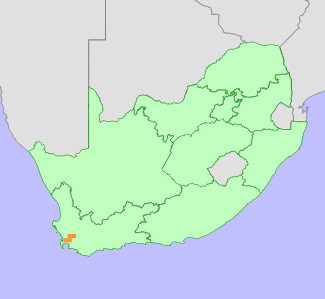|
Scientific Name | Leucospermum grandiflorum (Salisb.) R.Br. |
Higher Classification | Dicotyledons |
Family | PROTEACEAE |
Common Names | Grey-leaf Fountain Pincushion (e), Luisiesbos (a) |
National Status |
Status and Criteria | Vulnerable B1ab(ii,iii,iv,v)+2ab(ii,iii,iv,v) |
Assessment Date | 2020/06/18 |
Assessor(s) | A.G. Rebelo, H. Mtshali & L. von Staden |
Justification | The population of this local endemic has been fragmented due to extensive past habitat loss to timber plantations and agriculture, and it remains at seven locations within an extent of occurrence (EOO) of 772-914 km², and an area of occupancy (AOO) of 108-124 km². Habitat quality and number of mature individuals at the remaining locations continue to decline due to ongoing habitat loss on lower slopes, and alien plant invasion, too frequent fire and wild flower harvesting. It therefore qualifies for listing as Vulnerable under criterion B. |
Distribution |
Endemism | South African endemic |
Provincial distribution | Western Cape |
Range | Leucospermum grandiflorum is endemic to the Western Cape Province of South Africa, occurring from Paardeberg to Paarl. |
Habitat and Ecology |
Major system | Terrestrial |
Major habitats | Swartland Granite Renosterveld, Boland Granite Fynbos |
Description | It grows on hot, dry slopes, usually granitic clays, 120-700 m. Mature individuals are killed by fires, and only seeds survive. Seeds are released after ripening, and dispersed by ants to their underground nests, where they are protected from predation and fire. It is pollinated by birds. |
Threats |
| At least 57% of this species' habitat is irreversibly modified due to loss to pine plantations and cereals, vines, and buchu cultivation. There is no severe significant ongoing habitat loss, but some subpopulations are subjected to habitat degradation due to alien invasive plants (acacia and pines) spread and inappropriate fire management. Leucospermum grandiflorum is also threatened by wild flower harvesting. |
Population |
Leucospermum grandiflorum is currently known from 28 subpopulations that are mostly small. Although relatively safe on Paarl Mountain and Paardeberg with large subpopulations, the lowlands have been eliminated. The population is declining due to ongoing habitat loss and degradation.
|
Population trend | Decreasing |
Assessment History |
Taxon assessed |
Status and Criteria |
Citation/Red List version | | Leucospermum grandiflorum (Salisb.) R.Br. | EN A2c; B1ab(i,ii,iii,iv,v)+2ab(i,ii,iii,iv,v) | Raimondo et al. (2009) | | Leucospermum grandiflorum (Salisb.) R.Br. | Vulnerable | Hilton-Taylor (1996) | |
Bibliography |
Goldblatt, P. and Manning, J.C. 2000. Cape Plants: A conspectus of the Cape Flora of South Africa. Strelitzia 9. National Botanical Institute, Cape Town.
Hilton-Taylor, C. 1996. Red data list of southern African plants. Strelitzia 4. South African National Botanical Institute, Pretoria.
Raimondo, D., von Staden, L., Foden, W., Victor, J.E., Helme, N.A., Turner, R.C., Kamundi, D.A. and Manyama, P.A. 2009. Red List of South African Plants. Strelitzia 25. South African National Biodiversity Institute, Pretoria.
Rebelo, T. 2001. Sasol Proteas: A field guide to the proteas of southern Africa. (2nd ed.). Fernwood Press, Vlaeberg, Cape Town.
|
Citation |
| Rebelo, A.G., Mtshali, H. & von Staden, L. 2020. Leucospermum grandiflorum (Salisb.) R.Br. National Assessment: Red List of South African Plants version 2024.1. Accessed on 2025/11/01 |
 Comment on this assessment
Comment on this assessment

